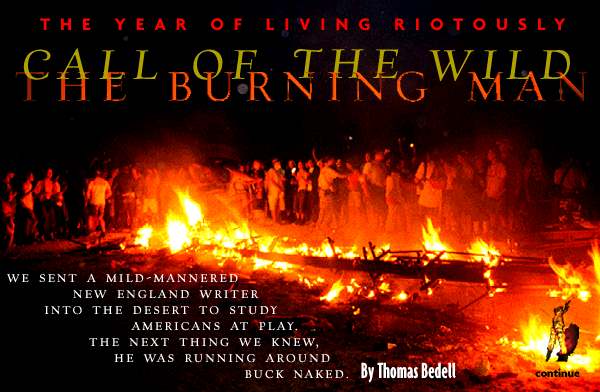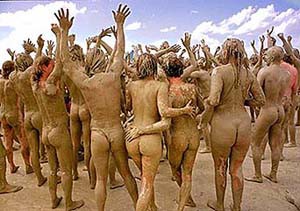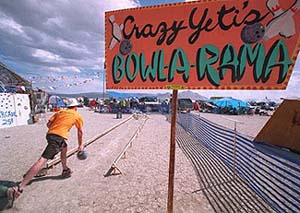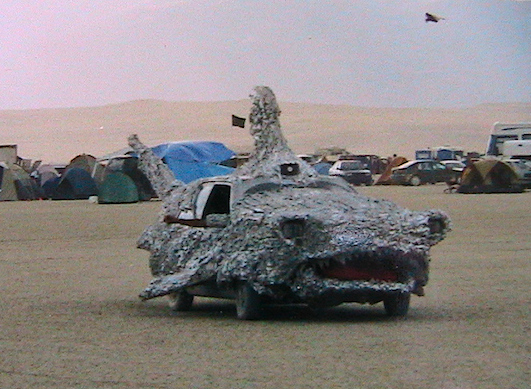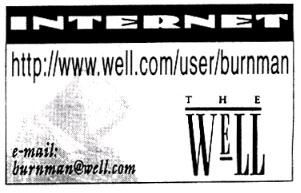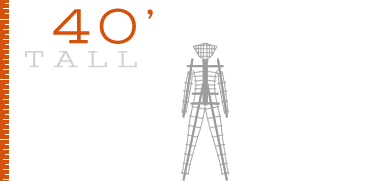
- Face: Blue neon outline front, Red neon outline back
- Diamond head, cross X chin
- Body: Blue neon inside front with red inside back, Slanted neon ribs
- Big feet, no platform
- Curved wood buttocks
- Man stands on ground
- Dual hay bale stacks near Man
- Sunday Burn
- After a jet car drive-by (piloted by Deso Molnar), the Burning Man is lit with a flame-thrower.
- Wind pushes fire to Man's left
"it’s a community, community is fine, you can build community anywhere. You should be building it where you live, whether that's in your neighborhood in down town Chicago or small town in the Sierra foothills or where every you live, it doesn't really matter. you just have to work at that shit, and this gives us an opportunity to come out and practice and try some things and see what happens."
Interviewee from Burning Man documentary - 1995 Joe Winston.
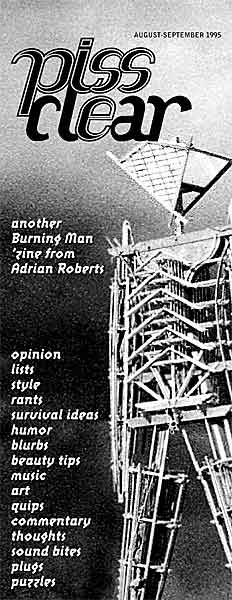
"Ah such auspicious beginnings. The first Issue of Piss Clear was simply a photo-copied 'zine -- two sheets of 8.5" x 11" paper folded lengthwise, so it could be easily stapled together. I think I printed just 200 copies.
... This was the year it rained on Saturday afternoon and the entire playa turned into a giant mud slick. If you've ever seen Burning Man photos of a bunch of naked people writhing around in what looks like a mud-soaked orgy, this was probably the year they were taken."
Adrian Roberts – Burning Man Live, 13 years of Piss Clear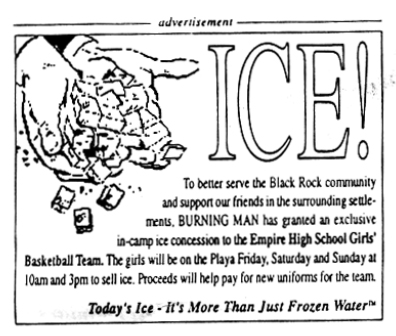
Friday, September 1, 1995 Black Rock Gazette
- Water Woman
- Large Camera Obscura pyramid
- COLLAPSINGsilence Performance Troupe -Butoh troupe
- Spontaneous Human Combustion by LA Cacophony
- MacSatans Beastro
- Java Cow
- Merman
- Sharkbait
- 3-Day Stubble
- Polkacide
- Wicked
- S.P.a.Z.
Trash fence was started in ’95 by a guy named Ember, or Larry Breed, a quiet guy who blossomed within Cacophony. (That’s what happens to all of us in Cacophony.) They were all going crazy over trash blowing downwind, and Ember suggested it to the ops department.
"They should make a bronze plaque for that guy for starting the trash fence," John Law says. "He did it for years after I left, too. It was all Ember’s idea, and I regard him as a hero." Summer Burkes - Early Man: Proto-DPW
By day this boom town sprawls around a central hub designed to form a giant compass, and settlement is so dispersed that communication between remote points becomes a (challenging) necessity.
Accordingly, we publish a daily desk-top newspaper and broadcast a 24 hour FM radio station. This year we will again transmit live video via satellite to the Internet and a plan is underway to feature other burning effigies simulcast in different time zones.
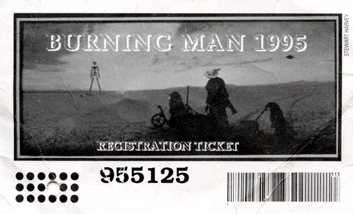
By night the playa is transformed into a galaxy of lights – synaptic nodes within a dreaming brain. Society convenes spontaneously around these fire-lit conferences. And there are times, as one drifts through this exotic nighttime world, when heaven and Earth seem to merge. Any given point of light in this disorienting darkness might be 4, 40, or – should one happen to fix on a low-lying star – 400 billion miles distant. The only orienting point becomes the four-story tall Burning Man. Car lights veer and drift on disconcerting vectors, and fireworks flash overhead. The blue neon glow of the Man becomes a beacon – the ultimate gathering place and ceremonial center for a society suspended in a void.
We believe the Black Rock Desert, a place which in itself is tantamount to Outer Space, also models the experience of technologic inner space; the equally vast frontier of the Internet. Stationed before our computers we are exiled from the passionate immediacy and physical contact that culture needs to survive. Perhaps communication, by itself, is not enough. A more direct communion is required. It is in this spirit that we offer Burning Man as a space station on the Internet. For many of us, it’s time to come home.
– Darryl Van Rhey
Interviewed by Robert B. Gelman on 13 August 1995 for RadioNet Talk Radio, the Internet’s first talk radio show on air on KSCO in Santa Cruz July ’94 to Oct ’96 and a RealAudio beta
“Welcome to Nowhere. Its name is whatever you name it. Its wealth is whatever you bring it. Next week it will be gone, but next week might as well be never. You are here now."
Stuart Mangrum – The Black Rock Gazette
From 1991 until 1994, the one-man Monkeybeans operation kept our band of displaced urbanites sufficiently caffeinated. By 1994, he worked about 20 hours a day. ... by the end of the weekend festivities, he declined to come again.
Facing the following year without a ready source of morning lattes, I proposed to Larry Harvey that we should have a camp café. After all, we had grown from a mere encampment to a fledgling city, with all the essential human services of any other city—a medical tent, the DPW, the Rangers, and so on. And a city was not complete without a café. Larry issued an immediate executive decision: "Okay. You do it."
That first year, I was given a budget to work with, around $400.00, to cover renting a machine, and getting enough coffee, cups, cream, and sugar to last us for a weekend. People volunteered to create a structure to house it and make signs. Others agreed to work the counter. ...
Café Temps Perdu—the café of lost time—opened on a beautiful day in the season of ’95 and got off to a limping start, since no one knew it was there, even if it was in the center of camp, and the only structure within the enormous circular center of camp—the bull’s eye—positioned so that the counter of the café looked down the lantern-lit Avenue of Art, and at the Burning Man at the very end. I said it should be there because then the workers could watch the burn from behind the counter.
However, on the second day, the weather took a sudden turn for the worse, and a virulent dust storm levelled the thing, leaving only the espresso machine standing... There’s only one reasonable thing to do in that environment, and that is be one with the dust. You have to revel in it.
The community rose to the challenge, having finally seen the espresso machine, and immediately seeing the value in getting the source of caffeine in functioning order. Volunteers stepped in and re-fashioned some kind of structure for us to operate in for the next 24 hours.
P Segal - as yet unpublished memoirs
- Burning Man becomes most populous settlement (albeit temporary) in Nevada's Pershing County. Camp is now known as "Black Rock City."
- Burning Man's Internet presence expands to include multiple interconnected Web sites.
- An email discussion list is established.
- The onsite daily newspaper, the Black Rock Gazette (edited and published by Stuart Mangrum), is uploaded to the World Wide Web each day of the event.
- Theme camp culture grows to dominate central camp design (superintended by Harley K. Bierman). Camps include: Algonquin Roundtable Camp, Tiki Camp, Bigfoot Shopping Maul and Croquet Camp.
- Cacophony Societies from Portland, Los Angeles and San Francisco make contributions.
- Burning Man comes under intense scrutiny of local and federal authorities. After the event, participating law enforcement and land management officials give Burning Man across-the-board "A-plus" ratings for safety, organization and cleanup.
- Major installations include Pepe Ozan's fire lingam and Ray Cirino's "Water Woman."
- CNN begins yearly coverage.
- Dust, wind, lightning and rain provide a dramatic shower.
- Large numbers of "mud people" take part in impromptu celebrations under a full double rainbow.
- After a jet car drive-by (piloted by Deso Molnar), the Burning Man is lit with a flame-thrower.
